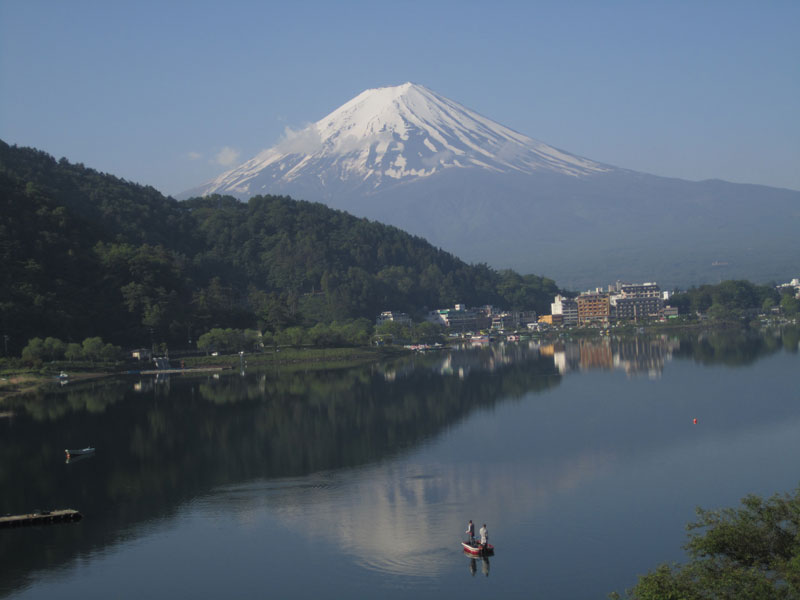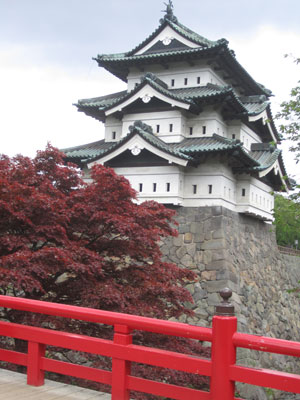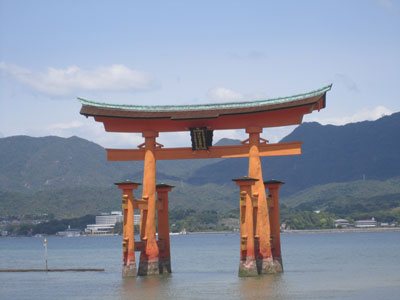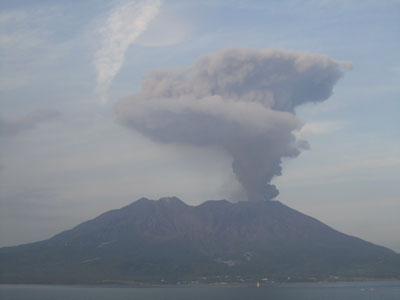Visiting three of Japan’s sites of extraordinary natural beauty by rail
This article appears on page 34 of the October 2014 issue.
My husband, Bernie, and I decided to revisit Japan in May 2014. Our main goal, besides visiting my family members, was to see once more the three most beautiful sites in Japan: Matsushima, near Sendai in northeastern Japan, Amanohashidate, in the north, and Miyajima, near Hiroshima.
We also had it in our minds to soak in a few of the numerous hot springs that the country has to offer. This was quite a big challenge for three short weeks, but we did our best.
Getting there and around
We flew Singapore Airlines from Los Angeles to Narita International Airport. Since we would arrive at almost 8 p.m., we had made reservations at Hotel Nikko Narita, which cost ¥16,500 (about $160) for two, with a full buffet breakfast and shuttle bus service between the airport and the hotel. We had a nice rest before heading back to Narita Airport the following morning to start our train journey through Japan.
As driving is on the left side of the street and the roads are rather narrow and empty spots for parking are very scarce, renting a car was out of the question. It is best to travel on Japan Rail (JR).
It is critical, if traveling in the countryside, to be familiar with Japanese or have someone who speaks, reads and understands Japanese with you, though in big cities you’ll be OK if you don’t know the language.
If you’re visiting Japan independently, you can obtain a Japan Rail Pass good for one, two or three weeks of travel in ordinary class or Green Car class (similar to the first-class section in air travel).
We got a 3-week Green Car voucher before we left the US and exchanged it for an actual rail pass at the Narita Airport/JR station. After that, getting on JR was a breeze; we just showed the pass to the station personnel whenever we went through the ticket gate.
If you want to reserve a seat on the bullet train, rapid train or limited express train, all you have to do is show your JR Pass at the Green Window, which almost all stations have, and say where and when you want to go (it can be on the same day but must be prior to boarding time).
Twice we did not have enough time to get seat reservations before boarding, but, luckily, the trains were not at all crowded and the conductor got us seats in the Green Car each time.
The Japan Rail Pass also allows travel on JR buses and ferries, and we noticed that JR has its own hotel chain, where pass holders can get discounts.
We traveled in Green Cars whenever they were available. We sat very comfortably and the windows were large and clean, so we could relax and enjoy sightseeing.
It was simply astonishing to see how many trains came and went. For example, we were transiting at Hachio¯ji station, outside Tokyo, and for travel in one direction only there were trains coming and going every five minutes.
You can ask any station agent from which platform your train is leaving or what time it is leaving, and the agent will pull out a pocket-sized time schedule and give you the correct information in seconds in a polite manner. During our 3-week stay we traveled a lot, and the JR staff were a great help.
Most of the stations had either an elevator or an escalator or both to go from one platform to another or to get in and out of the station. In the very remote countryside, there were none, but the station personnel usually helped us carry our carry-on-size suitcases up and down the stairs.
Seeing the sights
At what would be the first highlight of our trip, Matsushima, we visited Godaiji Shrine, a national treasure. This wooden structure was originally built in AD 600 and was redone in AD 1400. The shrine sits on a little island connected to the mainland by a footpath of about 50 feet.
The town and surrounding area of Matsushima were, unbelievably, left mostly intact following the earthquake and subsequent tsunami in March 2011. We were told that the hundreds of islets scattered in the bay, which make this place beautiful, reduced the severity of the tsunami’s impact, the waves becoming just a high tide. Of course, some of the old structures were badly damaged, and eventually they were taken down. We saw some high-water marks about seven to nine feet up the still-existing buildings.
The gentleman at the tourist information office reserved a beautiful ryokan (Japanese-style inn) for us. Zekkei no Yakata (House of Superior View) cost ¥60,000 ($585) for two for two nights, including fabulous kaiseki dinners served in our room and multicourse breakfasts. They also offer pickup and delivery service between the JR station and the ryokan.
We had a nice Japanese suite with a sitting room/bedroom and a balcony with a table and chairs overlooking the bay. The service was beautiful, and we were treated like royalty.
The second site we visited, Amanohashidate, is located almost directly north of Kyoto. This long stretch of land, measuring 3.6 kilometers, was formed when soil that washed down the hill and sand from the ocean collided. It is covered with about 8,000 pine trees, and you can walk or bike along this strip of land that crosses Miyazu Bay. One end of the strip provides access to the wilderness on the mainland, and the other end is connected to the town by a bridge that rotates to accommodate boats coming into the bay.
Both Matsushima and Amanohashidate are off the main tourist track, even though the areas are noted for their beauty. We saw no Western visitors there.
The third special site we visited was Itsukushima Shrine, located off Hiroshima on an island called Miyajima. The JR ferry provides transport there from Miyajimaguchi Station. This shrine was built by a powerful samurai lord, and its famous torii gate that stands in the bay was an entrance to the shrine used only by his family and him.
All about the onsen
Japan is full of volcanoes — active and not so active — so there are enough hot springs, or onsen, to supply the population’s needs. In the past, farmers, especially well-to-do rice farmers, would go to the hot springs after they completed the fall harvest in order to celebrate and to take care of aching bones and backs. The ryokans tried their best to entice them by preparing gourmet dinners using local products and fresh seafood, and this custom remains today.
Guests get dinner and breakfast plus unlimited use of the hot springs when staying at an onsen ryokan.
We stayed in these ryokans quite a few times, and the tariff, ¥13,000 to ¥25,000 ($140-$260), is not overly expensive when you consider the 12- to 15-course dinner served in your room each night and the huge selection of goodies to choose from at breakfast. The price is per person, not per room, as two meals are included. We always enjoyed the stay and the personal attention we got from staff.
They bring your dinner to your room, remove all the dishes afterward and spread futons for you to sleep on.
Some of the hot springs are very famous, such as Beppu or Hakone, but there are hundreds of spas all over Japan.
We chose some before we left home, some from brochures from the Japan National Tourism Organization and the rest by intuition. All worked out great, and we enjoyed each and every one of them.
Even in traditional ryokans, you can request either a Western-style room (with beds) or a traditional room (with a futon on the floor). At the high-end ryokans they serve dinner and breakfast in your room, but at the large complexes you must go to their dining room, where your table will be set up for you.
The baths, the main attraction, usually consist of two big, pool-like baths, one for men and one for women. Typically, there is one on the top floor of the inn, with a nice view through a full-length window, and the other is set up in a rocky cave. You can also rent a family bath, usually a bit smaller but tastefully set up with rocks and free-flowing hot water.
These baths are open all day and night, except when they are being cleaned. Some of the deluxe rooms each have their own bath in the room.
Volcano visits
Finally, we visited a few of Japan’s volcanoes. Aso, a very old volcano, has had numerous major eruptions. The caldera is about 120 kilometers in circumference, and visitors can drive along the top of the rim to reach the volcano-viewing spot/cable-car station. The cable car takes you to the viewpoint, where you can look into the crater, itself.
Unfortunately, the day we arrived at Aso, the cable car was not in operation; the gas fumes were too thick for safety, so viewing Aso up close was out. We could see the fumes coming out from the crater.
Volcano Sakurajima is one of the most active and dangerous volcanoes in the world. Its activity became more frequent in 1955, and thousands of small eruptions occur each year.
In August 2013 it spewed its highest volcanic column ever, reaching 15,000 feet. Sakurajima (Island of Cherry Blossoms) was an island in the Bay of Kagoshima. After a real violent eruption on Jan. 11, 1914, the volcano spewed out so much ash and lava that the island became connected to the mainland. There is now a nice road, so visitors can drive to Sakurajima.
When we arrived at JR Kagoshima-Chu¯o¯ Station, we could see Sakurajima smoking across the bay. We had reserved a hotel room with a volcano view, but before checking in we went for a sightseeing tour that took us around the volcano. We saw the volcano smoking gently but did not see anything too exciting, though we did get some ash and fine volcanic sand on us.
When we finally checked in at the hotel, we got to our room and opened the drapes and we saw it: the volcano across the bay was erupting! The eruption got more and more violent and we were mesmerized, glued to our window, the camera clicking and the video camera running.
The mountain is about 3,665 feet high, and the ash and smoke easily reached up to 5,000 feet, then slowly dissipated. What a show!
At that point, we had to run down to the dining room, as it was almost closing time.
The final volcano we visited, Mt. Fuji, is not really active (the last eruption was in the early 18th century); it’s just spectacular. Mount Fuji is the most sacred mountain in Japan.
From JR Chu¯o¯ Honsen O¯tsuki Station, we took the Fujikyuko Line (not part of JR) to the Kawaguchiko (Lake Kawaguchi) terminal station. At the tourist information center, we specifically asked for a hotel room with lake and mountain views.
Lake Kawaguchi is situated on the inland side of the mountain. It is best to see Mt. Fuji from the inland side, since the view from the sea side offers less chance of seeing the mountain clearly.
We were told that Hotel New Century fit our request the best, and the information center got us a shuttle to take us there.
Mount Fuji was covered by clouds that night, but it showed its magnificent self in the morning, around 4:30 a.m.
By the time the sun’s first light shone on the peak, we could see the mountain’s reflection on the lake. This rather special sight, called “upside-down Fuji,” is rarely seen. This was our last day in Japan, and what a lasting memory Mt. Fuji left us with!
A few details
Our cost for 21 days’ accommodation was approximately $3,900, mostly with two meals per day included. Our 3-week JR Pass cost ¥79,600 each, or $1,554 for both of us.
Meals, lunch and occasional dinners, plus private rail, bus and taxi transportation, admissions, etc., totaled about $2,000, and airfare was $2,200 for the two of us.
If there are any questions I can answer, email me at miyako.42@live.com. ITN




